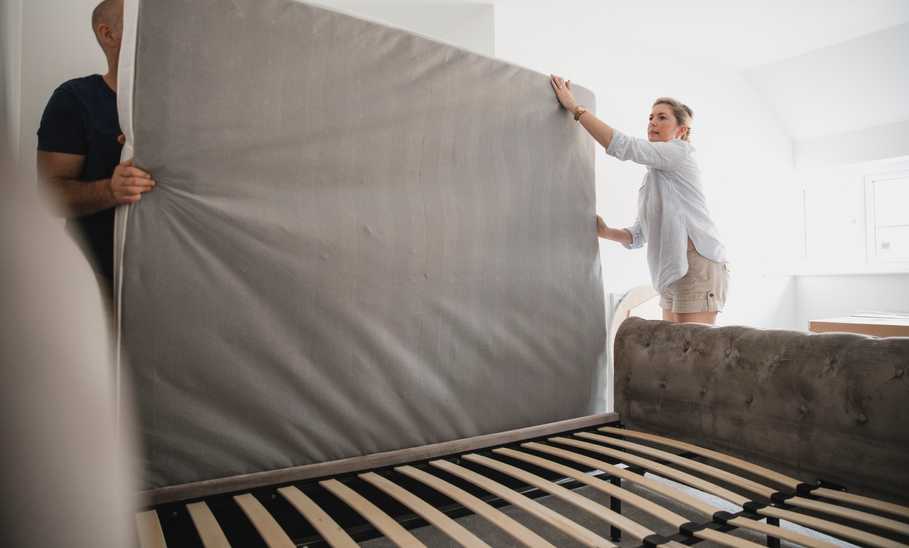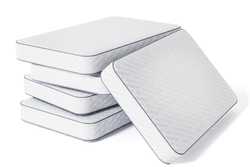How Often Should You Replace Your Mattress?

Our evaluations and opinions are not influenced by our advertising relationships, but we may earn a commission from our partners’ links. This content is created by TIME Stamped, under TIME’s direction and produced in accordance with TIME’s editorial guidelines and overseen by TIME’s editorial staff. Learn more about it.
A good night’s rest is important for physical and mental health. When you don’t get enough sleep (and many adults get less than the recommended seven hours a night), it can lead to the breakdown of your health. “Sleep, in general, is important for our overall health. It lets us recharge, rest, improve our mental health, and heal,” says Marius Hernandez, a Doctor of Physical Therapy based in Lorton, Virginia at the Anderson Clinic.
A good quality mattress is a key factor in getting restorative shut-eye, because it helps us fall into deep, uninterrupted sleep.. “When pain or discomfort keeps us up at night, it’s not only bad for our backs, but also our overall health,” says Hernandez.
In order to improve your quality of sleep, you need to replace your mattress over time. According to the Better Sleep Council, you should replace your mattress around seven years, but you may be able to keep your mattress for longer depending on its materials, usage and how you care for it over the long term. Many people keep theirs for up to 10 years before replacing it. .. Of course, mattress preferences are personal, and the lifecycle of one depends on a few factors, including how you care for it. Since mattresses are an investment, it’s important to make an informed decision about when to replace yours and what kind of mattress to replace it with.
![[object Object] [object Object]](https://saatva.imgix.net/products/saatva-classic/saatvana-angle/saatva-classic-saatvana-angle-16-9.jpg?dpr=1&auto=format&w=1025)
![[object Object] [object Object]](https://venus-media-library.s3.us-west-2.amazonaws.com/v2/time-ecomm/images/helix-moonlight.png)
Part of a mattress’ longevity has to do with how it’s made and what it’s made of. There are a few types of mattress materials, but the three most common are foam, innerspring and adjustable air. Foam mattresses may be latex, memory foam, or polyurethane foam mattresses. Innersprings have a steel coil support system and are usually covered by foam, fibers and other upholstery materials.
According to one bedding expert, higher-quality materials may lead to a longer lifespan. Look for mattresses made from natural latex, organic cotton, and high-density foam. Here are five of the most common types of mattresses and their typical lifespans.
If you sleep nightly on your mattress, and most of us do, you may need to replace it more often than, say, a guest room mattress, which may only be used a few times a year. The weight of sleepers may impact the longevity of a mattress as well—this is something you’ll be able to judge by any obvious wear and tear and the way the mattress feels to sleep on
Just like your sheets and blankets, proper maintenance and care will impact how long your mattress will last. Spot cleaning with a mild soap or detergent as soon as spills or mishaps occur will help prevent stains, vacuuming up dust and dirt every few months and using a protective cover are all ways to ensure its longevity.
If you take care of your bedding, it will last longer, and your mattress is no exception to this rule. Experts recommend cleaning your mattress at least twice a year and spot-cleaning any stains or spills right after they happen. As part of your cleaning routine, vacuum your mattress, and some mattress experts recommend pouring baking soda onto your mattress, letting it sit near a window to absorb sunlight, and leaving it on for 24 hours before vacuuming. This treatment should remove odors trapped within the mattress.
A mattress protector can help prolong your mattress's life by keeping stains, dust mites and dirt off the mattress. These protectors, along with mattress pads, are usually available in all sizes of beds from twin to California King and fit over the mattress much like a fitted sheet. The protector is usually made of cotton or other material that is machine-washable, so it can be washed as a regular part of your routine to keep your bedding clean.
How often you rotate or flip your mattress usually depends on the type of mattress you purchase. Following the directions on the particular kind you purchase is usually recommended. Rotating or flipping your mattress every few months is advised as a general rule of thumb.
Since comfort and support are two important qualities in a mattress, paying attention to the signs that yours might be hitting the end of its lifespan is important. These include:
Visible wear and tear: If you see rips, indentions or worn spots in your mattresses, these are all tell-tale signs that it might be time for a new mattress.
Sagging or lumps in the mattress: Sags, dips or lumps indicate that it may be time to replace your mattress, especially if it’s a spring mattress..
Worsening sleep quality: This is an elusive sign, but if you are suddenly not sleeping as well or as deeply as you have in the past, or your guest bed is more comfortable, it may have to do with your mattress.
Development of allergies or asthma symptoms: Mattresses trap allergens and if you find yourself sniffling, coughing and sneezing, it may be worth investigating if it’s coming from your mattress (or your pillows).
Comfort and support are the two of the most important factors when shopping for a new mattress, and every sleeper has their own individual comfort and support preferences. Mattress size, thickness, construction, and materials also factor in for many people. You may also want to consider how a mattress supports your back.
According to some bedding experts, latex is one of the most durable materials for a mattress. Memory foam can also be a good choice for durability, as well.
Maybe. Most mattresses should be replaced before 15 years, but if a mattress is still comfortable and provides the necessary support for good sleep, it might last 15 years. And It would depend on the sleeper and the mattress. For example, a latex mattress, known for its durability, could last 15 years.
The average lifespan of a mattress is approximately eight years.
Ikea recommends consumers of their mattress products replace them at least eight to 10 years.
The information presented here is created by TIME Stamped and overseen by TIME editorial staff. To learn more, see our About Us page.



